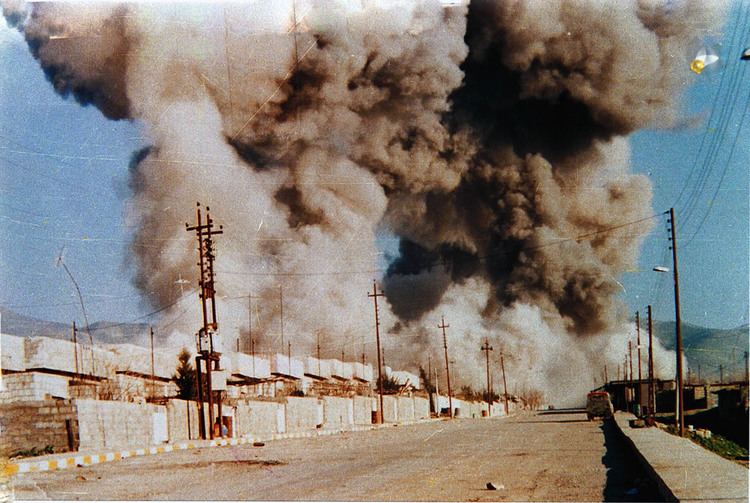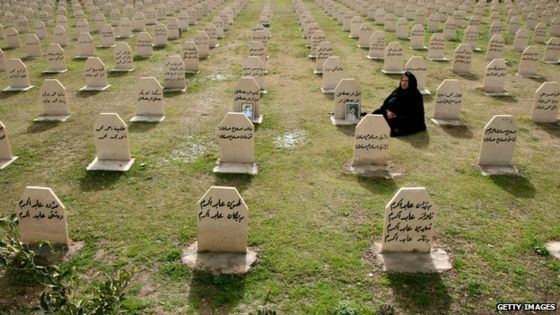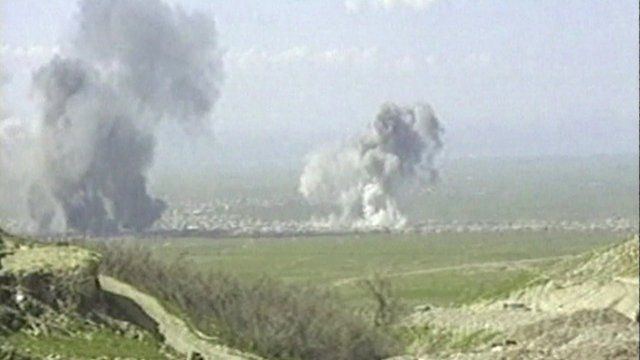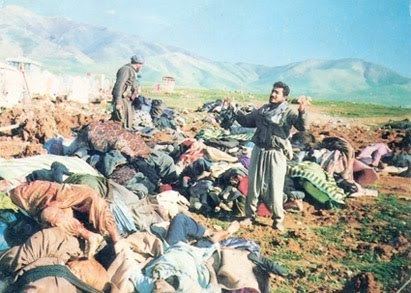Date 16 March 1988 | ||
 | ||
Similar Al‑Anfal campaign, Iran–Iraq War, Srebrenica massacre, Operation Dawn 8, Gulf War | ||
Halabja chemical attack 1988
The Halabja chemical attack (Kurdish: Kîmyabarana Helebce کیمیابارانی ھەڵەبجە), also known as the Halabja Massacre or Bloody Friday, was a massacre against the Kurdish people that took place on March 16, 1988, during the closing days of the Iran–Iraq War in the Kurdish city of Halabja in Southern Kurdistan. The attack was part of the Al-Anfal Campaign in northern Iraq, as well as part of the Iraqi attempt to repel the Iranian Operation Zafar 7. It took place 48 hours after the fall of the town to Iranian army.
Contents
- Halabja chemical attack 1988
- Background
- Chemical attack
- Discovery and response
- Destruction and partial restoration of Halabja
- Medical and genetic consequences
- Trials of Saddam and Chemical Ali
- Allegations of Iranian involvement
- 2006 Halabja memorial riot
- In popular culture
- Literature
- References

The attack killed between 3,200 and 5,000 people and injured 7,000 to 10,000 more, most of them civilians. Thousands more died of complications, diseases, and birth defects in the years after the attack. The incident, which has been officially defined by Supreme Iraqi Criminal Tribunal as a genocidal massacre against the Kurdish people in Iraq, was and still remains the largest chemical weapons attack directed against a civilian-populated area in history.

The Halabja attack has been recognized as a distinct event of the Anfal Genocide conducted against the Kurdish people by the Iraqi regime under Saddam Hussein. The Iraqi High Criminal Court recognized the Halabja massacre as an act of genocide on March 1, 2010, a decision welcomed by the Kurdistan Regional Government. The attack was also condemned as a crime against humanity by the Parliament of Canada.

Background
Northern Iraq was an area of general unrest during the early stage of the Iran–Iraq War, with the Kurdistan Democratic Party and Patriotic Union of Kurdistan militias joining forces, with Iranian support, in 1982 and 1983, respectively. The Kurdish rebellion was largely put down by mid-1980s. From 1985, however, the Iraqi Ba'athist regime under Saddam Hussein decided to eradicate pockets of Kurdish resistance in the north and strike down the peshmerga rebels by all means possible, including large-scale punishment of civilians and the use of chemical weapons. The Halabja event was also part of Iraqi efforts to counter-attack Kurdish and Iranian forces in the final stages of Operation Zafar 7.
Chemical attack

The five-hour attack began in the evening of March 16, 1988, following a series of indiscriminate conventional (rocket and napalm) attacks. Iraqi MiG and Mirage aircraft began dropping chemical bombs on Halabja's residential areas, far from the besieged Iraqi Army base on the outskirts of the town. According to regional Kurdish rebel commanders, Iraqi aircraft, coordinated by helicopters, conducted up to 14 bombings in sorties of seven to eight planes each. Eyewitnesses told of clouds of white, black and then yellow smoke billowing upward and rising as a column about 150 feet (50 m) in the air.

It was a beautiful spring day. As the clock approached 11:00 in the morning, I felt a strange sensation; my heart convulsed as if it were telling me that we were on the verge of a major calamity. Within minutes, artillery rounds began to explode in Halabja and planes began dropping bombs on the town. The bombing was concentrated on the northern neighborhoods, so we ran and hid in our basement. At 2 o'clock in the afternoon, as the intensity of the bombing wound down, I carefully sneaked out of the basement to the kitchen and carried food to my family. When the bombing stopped, we began to hear noises that sounded like metal pieces falling on the ground. But I didn’t find an explanation.
I saw things that I won't forget for as long as I live. It started with a loud strange noise that sounded like bombs exploding, and a man came running into our house, shouting, 'Gas! Gas!' We hurried into our car and closed its windows. I think the car was rolling over the bodies of innocent people. I saw people lying on the ground, vomiting a green-colored liquid, while others became hysterical and began laughing loudly before falling motionless onto the ground. Later, I smelled an aroma that reminded me of apples and I lost consciousness. When I awoke, there were hundreds of bodies scattered around me. After that I took shelter again in a nearby basement and the area was engulfed by an ugly smell. It was similar to rotting garbage, but then it changed to a sweet smell similar to that of apples. Then I smelled something that was like eggs.
Survivors said the gas at first smelled of sweet apples and reported that people died in a number of ways, suggesting a combination of toxic chemicals. Some of the victims "just dropped dead" while others "died of laughing," while still others took a few minutes to die, first "burning and blistering" or coughing up green vomit. Many were injured or perished in the panic that followed the attack, especially those who were blinded by the chemicals. It is believed that Iraqi forces used multiple chemical agents during the attack, including (mustard gas) and nerve agents. Some sources have also pointed to the blood agent hydrogen cyanide. Most of the wounded taken to hospitals in the Iranian capital Tehran were suffering from mustard gas exposure.
Some consider the event as separate from the Operation Anfal (the 1986–1989 campaign conducted by Saddam's regime's in order to terrorize the Kurdish rural population and end the peshmerga rebellions by brutal means), as the Iranian troops allied to the rebels were also involved in the Halabja events. Nevertheless, the victims of the tragedy are often included in accounting the deaths attributable to the Anfal campaign, which was characterised by the widespread and indiscriminate use of chemical weapons by Iraq. Prior to the Halabja incident there were at least 21 documented smaller-scale chemical attacks against Iraqi Kurds, none of which prompted any serious response from the international community.
Discovery and response
The first images after the attack were taken by Iranian journalists who later spread the pictures in Iranian newspapers. Footage taken by a British ITN camera crew, airlifted by the Iranians, was also shown worldwide via news programmes. Some of those first pictures were taken by Iranian photographer Kaveh Golestan, who described the scene to Guy Dinmore of the Financial Times. He was about eight kilometres outside Halabja with a military helicopter when the Iraqi MiG-23 fighter-bombers flew in. He said "it was not as big as a nuclear mushroom cloud, but several smaller ones: thick smoke." Golestan was shocked by the scenes on his arrival in the town, though he had seen gas attacks before at the front lines:
It was life frozen. Life had stopped, like watching a film and suddenly it hangs on one frame. It was a new kind of death to me. (…) The aftermath was worse. Victims were still being brought in. Some villagers came to our chopper. They had 15 or 16 beautiful children, begging us to take them to hospital. So all the press sat there and we were each handed a child to carry. As we took off, fluid came out of my little girl's mouth and she died in my arms.
Saddam Hussein's government officially blamed Iran for the attack. Iraqi foreign minister Tariq Aziz stated categorically: "There is no use of chemical weapons and no necessity of using them." The casualties were declared "chemical martyrs" by the Kurds. International response at the time was muted. The United States intelligence and government suggested that Kurdish civilians were not a deliberate target, and even that Iran was indeed responsible. A briefing paper by the British Foreign and Commonwealth Office stated: "We believe it better to maintain a dialogue with others if we want to influence their actions. Punitive measures such as unilateral sanctions would not be effective in changing Iraq's behaviour over chemical weapons, and would damage British interests to no avail."
Destruction and partial restoration of Halabja
Survivors assisted by peshmerga and Iranians hastily buried most of the dead in makeshift mass graves. After Halabja was retaken from Iranian and Kurdish rebel forces, Iraqi troops in NBC suits came to Halabja to study the effectiveness of their weapons and attacks. The town, still littered with unburied dead, was then systematically razed by Iraqi forces using bulldozers and explosives. It was partially rebuilt by the returning Kurds later, even as chemical weapons contaminated the food and water supplies, soil, and animal populations. The Japanese government financed a $70 million project to provide access to safe drinking water in response to this.
Medical and genetic consequences
Ten years later, in 1998, at least 700 people were still being treated for the severe after effects of the attack and 500 of them were judged to be critically ill, even as "the most severe cases may already have died." In surveys by local doctors, a higher percentage of medical disorders, miscarriages (outnumbering live births and 14 times higher than normal), colon cancer (10 times higher than normal), and heart diseases (quadrupled between 1990 and 1996) were found in Halabja compared to Chamchamal. Additionally, "other cancers, respiratory ailments, skin and eye problems, fertility and reproductive disorders are measurably higher in Halabja and other areas caught in chemical attacks." Some of those who survived the attack or were apparently injured only lightly at the time later developed medical problems doctors believe stemmed from the chemicals, and there are concerns that the attack may be having a lasting genetic impact on the Kurdish population, as preliminary surveys showed increased rates of birth defects.
Trials of Saddam and 'Chemical Ali'
Saddam Hussein was not charged by the Iraqi Special Tribunal for crimes against humanity based on the events at Halabja. However, Iraqi prosecutors had "500 documented baskets of crimes during the Hussein regime" and Hussein was condemned to death based on just one case, the 1982 Dujail Massacre. Among several documents revealed during the trial of Saddam Hussein, one was a 1987 memo from Iraq's military intelligence seeking permission from the president's office to use mustard gas and the nerve agent Sarin against Kurds. A second document said in reply that Saddam had ordered military intelligence to study the possibility of a "sudden strike" using such weapons against Iranian and Kurdish forces. An internal memo written by military intelligence confirmed it had received approval from the president's office for a strike using "special ammunition" and emphasized that no strike would be launched without first informing the president. Saddam himself told the court: "In relation to Iran, if any military or civil official claims that Saddam gave orders to use either conventional or special ammunition, which as explained is chemical, I will take responsibility with honor. But I will discuss any act committed against our people and any Iraqi citizen, whether Arab or Kurdish. I don't accept any insult to my principles or to me personally." Kurdish survivors had no doubt Saddam was personally responsible and were disappointed he was being tried only over the killings in Dujail. Saddam was executed by hanging on December 30, 2006.
Saddam's cousin Ali Hassan al-Majid (who commanded Iraqi forces in northern Iraq during that period, which earned him a nickname of 'Chemical Ali') was condemned to death by hanging by an Iraqi court in January 2010, after being found guilty of orchestrating the Halabja massacre. Al-Majid was first sentenced to hang in 2007 for his role in a 1988 military campaign against ethnic Kurds, codenamed Anfal, and in 2008 he also twice received a death sentence for his crimes against the Iraqi Shia Muslims, in particular for his role in crushing the 1991 uprisings in southern Iraq and his involvement in the 1999 killings in the Sadr City district of Baghdad (then called Saddam City). Al-Majid did not express remorse at his trials, stating his actions were in the interests of Iraqi security. He was executed by hanging on January 25, 2010.
Allegations of Iranian involvement
The U.S. State Department, in the immediate aftermath of the incident, took the official position that Iran was partly to blame. A preliminary Defense Intelligence Agency (DIA) study at the time reported that Iran was responsible for the attack, an assessment which was used subsequently by the Central Intelligence Agency (CIA) for much of the early 1990s. The CIA's senior political analyst for the Iran-Iraq war, Stephen C. Pelletiere, co-authored an unclassified analysis of the war which contained a brief summary of the DIA study's key points. The CIA altered its position radically in the late 1990s and cited Halabja frequently in its evidence of weapons of mass destruction before the 2003 invasion of Iraq. Pelletiere claimed that a fact that has not been successfully challenged is that Iraq was not known to have possessed the cyanide-based blood agents determined to have been responsible for the condition of the bodies that were examined, and that blue discolorations around the mouths of the victims and in their extremities, pointed to Iranian-used gas as the culprit. Leo Casey writing in Dissent Magazine argued that "none of the authors of these documents […] had any expertise in medical and forensic sciences, and their speculation doesn't stand up to minimal scrutiny."
Joost Hiltermann, who was the principal researcher for Human Rights Watch between 1992–1994, conducted a two-year study of the massacre, including a field investigation in northern Iraq. According to his analysis of thousands of captured Iraqi secret police documents and declassified U.S. government documents, as well as interviews with scores of Kurdish survivors, senior Iraqi defectors and retired U.S. intelligence officers, it is clear that Iraq carried out the attack on Halabja, and that the United States, fully aware of this, nevertheless accused Iran, Iraq's enemy in a fierce war, of being partly responsible for the attack. This research concluded there were numerous other gas attacks, unquestionably perpetrated against the Kurds by the Iraqi armed forces. According to Hiltermann, the literature on the Iran-Iraq war reflects a number of allegations of chemical weapons use by Iran, but these are "marred by a lack of specificity as to time and place, and the failure to provide any sort of evidence." Hiltermann called these allegations "mere assertions" and added that "no persuasive evidence of the claim that Iran was the primary culprit was ever presented." An investigation conducted by Dr Jean Pascal Zanders, Project Leader of the Chemical and Biological Warfare Project at the Stockholm International Peace Research Institute, into responsibility for the Halabja massacre also concluded in 2007 that Iraq was the culprit, and not Iran.
In August 2013, Foreign Policy charged, based on recently declassified CIA documents and interviews with former intelligence officials, the U.S. had firm evidence of Iraqi chemical attacks beginning in 1983. Saddam's regime also received intelligence assistance from the CIA in 1987 prior to the Iraqis' early 1988 launch of sarin attacks to stop the potentially decisive Iranian offensive to capture the southern city of Basra, which, if successful, might have resulted in a collapse of Iraqi military and government.
2006 Halabja memorial riot
In March 2003, the Monument of Halabja Martyrs was built in the still largely ruined city. On March 16, 2006, a few thousand angry residents rioted at the site in protest of what they perceived as the neglect of the living and capitalizing on the tragedy by the Kurdish leadership. The memorial was set on fire, destroying most of its archives; one of the rioters was shot dead by the police and dozens of people were injured. It was later rebuilt as the Halabja Memorial Monument, also known as Halabja Monument and Peace Museum.
